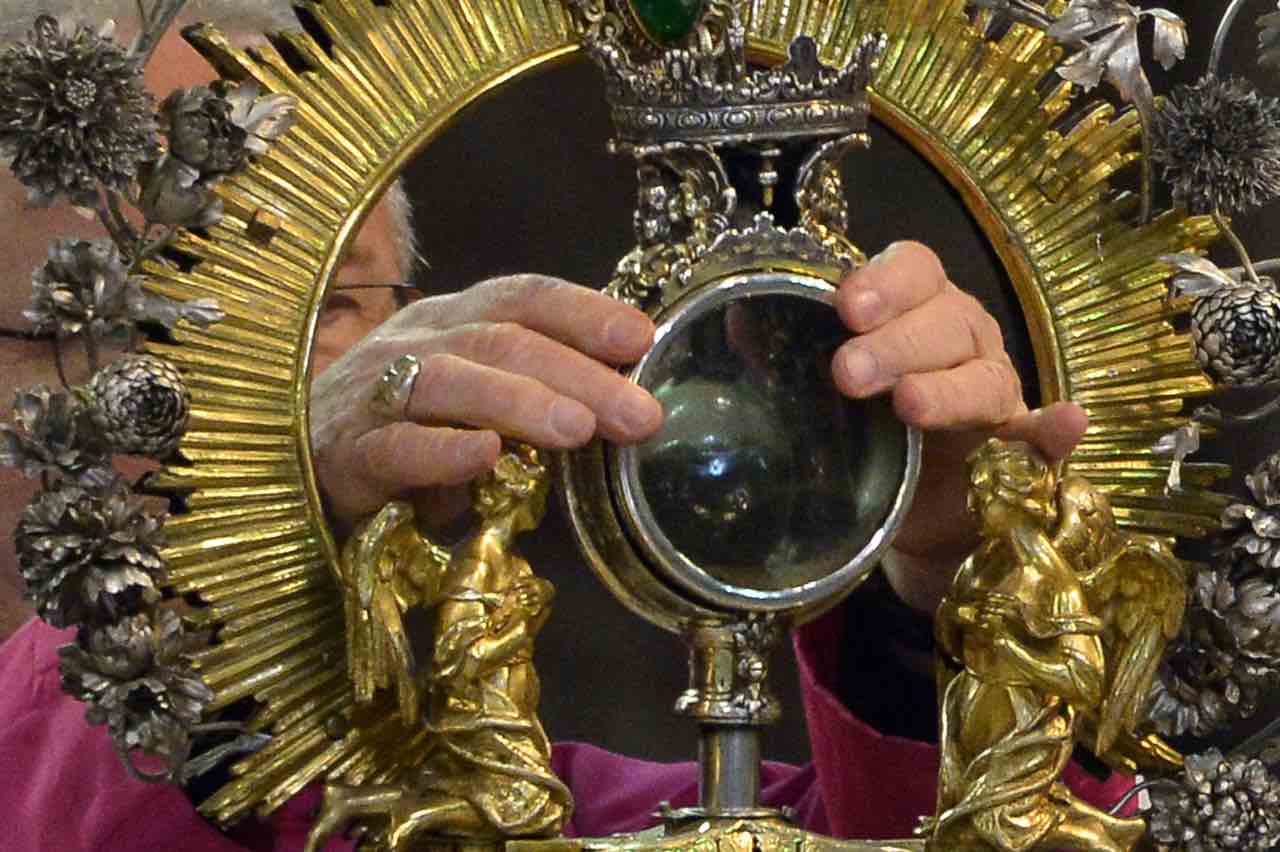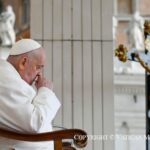Tempo di lettura: 11 minuti
Read the story of San Gennaro
Summary
“… Come questo sangue che ribolle a ogni festa, così la fede del popolo di Napoli possa ribollire, rifiorire e affermarsi…” (Paolo VI, discorso ai pellegrini partenopei, 1966)
Nato a Napoli, o forse a Benevento, nella seconda metà del III secolo, Gennaro a trent’anni è già vescovo della città sannita, dove è amato dai fedeli e rispettato dai pagani per le opere di carità nei confronti dei poveri tra i quali non fa distinzione.
We are in the early period of Diocletian's empire, when Christians were granted a certain freedom of worship and were even allowed to aspire to high civil offices. But then, in 303, everything changed and the Christians became the enemy to be eradicated.
Martyr of the faith
The episode that leads to the martyrdom of Gennaro takes place at the beginning of the fourth century, with the resumption of persecutions against Christians.
Da tempo Gennaro è grande amico di Sossio, diacono della città di Miseno. Un giorno, mentre questi legge il Vangelo in chiesa, Gennaro ha una visione: una fiamma sopra la sua testa.
Recognized as the symbol of future martyrdom, Gennaro gives thanks to the Lord and asks to be able to have the same fate. The bishop therefore invites Sossio to the pastoral visit he is planning to Pozzuoli, to talk about faith; the deacon sets off, but during the journey he is joined by the guards sent by Dragonzio, governor of Campania, and is imprisoned.
In prison he receives a visit from Gennaro who is accompanied by the deacon Festo and the reader Desiderio: the three try to intercede for the release of Sossio, but in response they all get sentenced to be torn to pieces by bears.
La notizia della loro pubblica morte, però, non è ben accolta dal popolo e così, temendo una rivolta, il governatore la commuta in una più discreta decapitazione, lontano dagli occhi della gente. Seguirà anche il martirio di Procolo, diacono della chiesa di Pozzuoli, e dei fedeli Eutiche e Acuzio che avevano pubblicamente criticato l’esecuzione.
Another version of martyrdom
Since such ancient sources don't all agree on the martyrdom of San Gennaro, here is another hypothesis of what probably could have happened.
Gennaro is on his way to Nola: here the perfidious judge Timoteo imprisons him on charges of proselytism which violates the imperial edicts. The tortures inflicted on the Saint, however, did not affect his body nor his faith; therefore Timoteo has him locked up in a furnace from which, once again, Gennaro emerges unharmed. In the end he is sentenced to be beheaded in a locality near the so-called Solfatara.
During the transfer he meets a beggar who asks him for a piece of his garment to keep as a relic: the Saint replies that he can keep the whole handkerchief that he will tie around his neck before execution. Before the end, however, Gennaro puts a finger to his throat which is cut by the blade together with the handkerchief and also kept as a relic.
The miracle of blood liquefaction
As was customary on the occasion of the execution of martyrs, upon Gennaro's death a woman, Eusebia, arrives and collects the blood shed by the bishop already smelling of sanctity in two ampoules.
Le consegnerà al vescovo di Napoli, che farà erigere due cappelle in onore del sacro trasporto: S. Gennariello al Vomero e S. Gennaro ad Antignano. Il corpo, invece, seppellito nell’agro Marciano, subisce una prima traslazione nel V secolo, quando il culto del Santo è già molto diffuso. Gennaro, poi, sarà canonizzato da Sisto V nel 1586.
As for the relic of the blood, this is exhibited for the first time in 1305, but the miracle by which it almost seems to boil and returns to the liquid state in which it remains for the following octave, occurs for the first time on August 17, 1389, after a severe famine.
Today the miracle is repeated three times a year: the first Saturday of May in memory of the first translation; September 19, liturgical memory of the Saint and date of martyrdom; on December 16 to commemorate the disastrous eruption of Vesuvius in 1631, blocked after the invocation of the Saint.
Le due ampolle sono custodite in una teca d’argento voluta da Roberto d’Angiò, nella Cappella del Tesoro di S. Gennaro nel Duomo di Napoli.
source © Vatican News – Dicasterium pro Communicatione
Patrono di Napoli
Gennaro è il santo Patrono principale di Napoli e, negli ultimi anni del pontificato di San Giovanni Paolo II (Karol Józef Wojtyła, 1978-2005), è tornato ad essere patrono delle due Sicilie, cioè del sud Italia.
Sulla sua vita non si hanno notizie storicamente documentate. Nato a Napoli nella seconda metà del III secolo, la sua storia è stata tramandata da opere agiografiche dove la realtà e la leggenda spesso si intrecciano e mescolano in un unico racconto, i cui elementi storici non sempre sono facilmente distinguibili.
The fact that led to the consecration of Gennaro would have occurred at the beginning of the fourth century, during the persecution of Christians by the emperor Diocletian.
Benevento
Gennaro was the bishop of Benevento and went together with the reader Desiderio and the deacon Festo to visit the faithful in Pozzuoli. The deacon of Misenum, Sossio - already a friend of Gennaro who had come to see him in the past in Misenum to discuss faith and divine laws -, wanting to go to assist in the pastoral visit, was instead arrested along the way by order of the persecutor Dragonzio, governor of Campania.
Gennaro, together with Festo and Desiderio, then went to visit the prisoner, but, having interceded for his release, and having made a profession of Christian faith, they too were arrested and condemned by Dragonzio to be torn to pieces by bears in the amphitheater of Pozzuoli. The next day, however, due to the absence of the governor himself, busy elsewhere, the execution was suspended.
Dragonzio then ordered that Gennaro and his companions be cut off their heads. Conducted near theVolcano Forum(the current Solfatara of Pozzuoli), they were beheaded in the year 305; Gennaro's body would have been buried in the Agro Marciano (Fuorigrotta?).
According to tradition, immediately after the beheading, blood was kept, as was the custom at the time, collected by a pious woman named Eusebia who enclosed it in two ampoules; they have become a typical iconographic attribute of San Gennaro. However, the story of the pious woman is recent and appears published for the first time only in 1579, in the volume by the Neapolitan canon Paolo Regio on“Le vite de’ sette Santi Protettori di Napoli”.
Very ancient liturgical documents, such as the Carthaginian calendar (written shortly after 505) and the Geronimian Martyrology of the 5th century assign September 19 as the date of the martyrdom of Gennaro and his companions; instead they indicate April 13 as the date of the first translation of the remains of the saint. Even in another martyrology dating back to the eighth century, written by the English monk Bede, September 19 is indicated as the date of martyrdom.
Nel calendario marmoreo di Napoli la data del 19 settembre viene indicata come “dies natalis”of San Gennaro. All these sources, and many others, attest that the veneration for the saint has very ancient origins dating back to the time of his martyrdom or, at the latest, to that of the first translation of his remains, which took place in the fifth century.
Le reliquie del santo furono trasportate dal re Giovanni I di Napoli nelle catacombe napoletane a Capodimonte che presero il nome del Santo, e qui furono centro di vivissimo culto. Di là il principe di Benevento Sicone, assediando la città di Napoli, nell’ 831, ne approfittò per impossessarsi dei resti mortali che riportò nella sua città, sede episcopale.
The holy relics were placed in the Cathedral - which was then called Santa Maria di Gerusalemme - where they remained until 1154. In that year, in fact, considering that the city of Benevento was no longer safe, the king of Sicily William I, called Malo (1120-1166), provided that they were transferred to the Abbey of Montevergine.
In Montevergine, however, the devotion of the pilgrims who went there was directed above all to S. Guglielmo and the very popular Byzantine icon of the Madonna called“Mamma Schiavona”, sicché di S. Gennaro si perse ben presto la memoria e addirittura la cognizione del suo luogo di sepoltura. A Napoli, invece, rimaneva vivissimo il culto, anche per la presenza delle altre sue reliquie: il capo e le ampolle col suo sangue.
Carlo II d’Angiò, detto lo zoppo (1248-1309), – re di Napoli (1285-1309) e di Sicilia (1285-1302) – dopo aver fatto eseguire dai maestri orafi francesi Stefano Godefroy, Guglielmo di Verdelay e Milet d’Auxerre un preziosissimo busto-reliquiario in argento dorato per contenere la testa e le ampolle col sangue del santo, espose per la prima volta la reliquia alla pubblica venerazione nel 1305. Suo figlio Roberto d’Angiò, detto il Saggio (1277 – 20 gennaio 1343), invece, fece realizzare la teca d’argento che custodisce le due ampolle del sangue.
However, the liquefaction of the blood is not attested before 17 August 1389, when the miracle took place during a solemn procession undertaken due to a severe famine.
Quando a Montevergine, per merito del cardinale Giovanni di Aragona, furono ritrovate le ossa di S. Gennaro, collocate al di sotto dell’altare maggiore, la potente famiglia dei Carafa si impegnò, grazie soprattutto all’interessamento del cardinale Oliviero e con il sostegno di suo fratello l’arcivescovo napoletano Alessandro Carafa, affinché le reliquie tornassero a Napoli: la cosa avvenne nel 1497, non senza l’opposizione da parte dei monaci di Montevergine.
Come degno luogo per ospitarle, il cardinale Oliviero Carafa fece costruire nel Duomo di Napoli, al di sotto dell’altare maggiore, una cripta d’eccezione in puro stile rinascimentale: la Chapel of Succorpo.
A seguito di una terribile pestilenza che imperversò a Napoli fra il 1526 ed il 1529, i napoletani fecero voto a S. Gennaro di edificargli una nuova cappella all’interno del Duomo. Benché i lavori fossero iniziati solo nel 1608 e siano durati quasi quarant’anni, la sfolgorante e ricca Chapel of the Treasure of S. Gennaroit was finally consecrated in 1646.
Above its splendid gate, created by Cosimo Fanzago, is the inscription“Divo Ianuario e fame bello peste ac Vesaevi igne miri ope sanguinis erepta Neapolis civi patr. Vindici” (“A San Gennaro, al cittadino salvatore della patria, Napoli, salvata dalla fame, dalla guerra, dalla peste e dal fuoco del Vesuvio, per virtù del suo sangue miracoloso, consacra”).
On February 25, 1964, the Cardinal Archbishop Alfonso Castaldo made the canonical recognition of the venerated relics:“The bones were found well kept, in an ovoid-shaped olla engraved with the calligraphic inscription, Corpus Sancti Jannuarii Ben. EP".
A scientific survey carried out on 7 March 1965 by Professor G. Lambertini established that the character to which the bones belong is to be identified as a young man (35 years old) of very tall stature (1.90m).
Secondo la leggenda, il sangue di S. Gennaro si sarebbe liquefatto per la prima volta ai tempi di Costantino, quando il vescovo S. Severo (secondo altri fu il vescovo Cosimo) trasferì le spoglie del santo dall’Agro Marciano, dove era stato sepolto, a Napoli.
During the journey he would have met the nurse Eusebia with the vials of the Saint's blood: in the presence of the head, the blood in the vials would have melted.
Oggi le due ampolle, fissate all’interno di una piccola teca rotonda realizzata con una larga cornice in argento e provvista di un manico, sono conservate nel Duomo di Napoli. Delle due ampolle, una è riempita di 3/4, mentre l’altra più alta è semivuota poiché parte del suo contenuto fu sottratto da re Carlo III di Borbone che lo portò con sé in Spagna.
Three times a year :
1. il primo sabato di maggio e negli otto giorni successivi, in ricordo della prima traslazione da Pozzuoli a Napoli;
2. on 19 September and for the whole octave, anniversary of the beheading;
3. on 16 December «the feast of the patronage of St. Gennaro», in memory of the disastrous eruption of Vesuvius in 1631, blocked after invocations to the saint.
during a solemn religious ceremony led by the archbishop, the faithful flock to witness the "miracle of the liquefaction of the blood of San Gennaro".
Il popolo napoletano nei secoli ha voluto vedere nella velocità del prodigio, un auspicio positivo per il futuro della città, mentre una sua assenza o un prolungato ritardo è visto come fatto negativo per possibili calamità da venire. La catechesi costante degli ultimi arcivescovi di Napoli ha convinto la maggioranza dei fedeli, che, anche la mancanza del prodigio o il ritardo vanno vissuti con serenità e intensificazione, semmai, di una vita più cristiana.
La liquefazione del sangue è innegabile e spiegazioni scientifiche finora non se ne sono trovate, come tutte le ipotesi contrarie formulate nei secoli, non sono mai state provate. È singolare il fatto, che a Pozzuoli, contemporaneamente al miracolo che avviene a Napoli, la pietra, conservata nella chiesa di S. Gennaro (vicino alla Solfatara), che si crede sia il ceppo su cui il martire poggiò la testa per essere decapitato, diventa più rossa.
Il vostro servitore, che ha preparato questa composizione agiografica, ha assistito, durante sei anni, molto da vicino, essendo seminarista, negli anni 50/60, al Seminario Arcivescovile di Napoli/Capodimonte, alle diverse liquefazioni del sangue di S. Gennaro che avvengono, “naturalmente", only and only thanks to the fervent, and often insistent, prayers of the “Pastor" di Napoli e del suo “gregge".(gpm)
For further information: Cathedral of Naples

source © gospeloftheday.org





